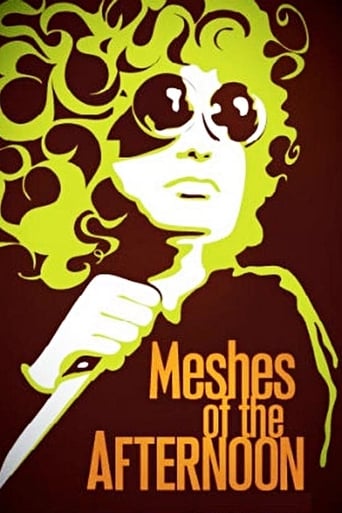gavin6942
A woman returning home falls asleep and has vivid dreams that may or may not be happening in reality. Through repetitive images and complete mismatching of the objective view of time and space, her dark inner desires play out on-screen.The film was the product of Deren's and Hammid's desire to create an avant garde personal film that dealt with devastating psychological problems, like the French surrealist films of the 1920s such as Salvador Dalí and Luis Buñuel's Un Chien Andalou (1929) and L'Age d'Or (1930).In 1990, Meshes of the Afternoon was selected for preservation in the United States National Film Registry by the Library of Congress as being "culturally, historically, or aesthetically significant", going into the registry in the second year of voting. In 2015 the BBC named the film the 40th greatest American movie ever made.The dreamlike (or nightmarish) atmosphere of Meshes has influenced many subsequent films, notably David Lynch's Lost Highway (1997). Jim Emerson has also noted the influence of Meshes within David Lynch's film, Inland Empire. Meshes also had a clear influence on Lynch's film Mulholland Drive with dual roles, a mysterious figure, winding Hollywood road, a dream within a dream, a woman viewing her own body in a dream, and iconic objects such as a key and a telephone.This film is incredible, and it shocks me that it and its creators are not better known. They deserve to be on the same level as Bunuel and Lynch, but yet do not seem to be known outside of those who really have a passion for avant-garde or surreal film.
Horst in Translation ([email protected])
This is the first short film from notable experimental film maker Maya Deren. She was still in her 20s when she wrote, directed and starred in "Meshes of the Afternoon" and got help from her then husband Alexander Hammid in all these areas except writing. It runs for 14 minutes and is entirely black-and-white. Nobody's talking, but it is not a silent film. It's obviously a story about dream and reality and the boundaries between these two not being always very clear. To me, the most interesting thing about it is probably that it was made in the US during World War II. Now if you know a bit about film history, you will know that, at this point in time, especially the American cartoon and war documentary industries were really booming. So these 14 minutes are something entirely different compared to the latest trends in movies back then. However, I have to say I found it boring and don't have the slightest need to rewatch this anytime soon. The depiction of death was pretty nice and so were Deren's look. Still not enough, not recommended.
MartinHafer
Like many of the art films, Maya Deren's "Meshes in the Afternoon" defies description as well as a numerical rating. After all, how can you rate or adequately describe something that deliberately avoids being cinematic and is meant to confuse and provoke the viewer?!This film consists of a lot of bizarre camera-work--and Deren is the subject in most of the shots. But, it isn't until later in the film that you actually see her face--up until then, it's feet, hands and an eye that the camera shows the viewer. There also is an angel of death- like being with a mirror for a face and lots of strange camera tricks. So what does all this mean? You have to decide for yourself, though I think it's pretty clearly about alienation and death. But what do I know?!The bottom line is that like art films, this one is strange and probably won't appeal to the average person. But, it is impressively strange and unusual--and it's worth a viewing if your are the right sort of person who appreciates avant garde films.
ackstasis
The most striking image of 'Meshes of the Afternoon (1943)' is that of Maya Deren trapped behind glass, staring mournfully outside, her hands pressed up against the reflection of trees outside her window. The sensation of being "trapped" within one's own household must have been common for many wives during the 1940s, particularly given that most husbands were abroad fighting for their country. This film, co-directed by Deren and her then-husband Alexander Hammid, to me seems to depict a woman confined within an apathetic marriage. Arriving home, Deren's initially-faceless woman collects a solitary flower from the footpath, grasping for a hint of romance in her otherwise dreary existence. A phone hangs off its hook, implying the disconnection between husband and wife. A key transforms into a kitchen knife, and vice versa. Trapped within this loveless marriage, Deren contemplates two courses of action to free herself from these martial bonds: kill her husband, or kill herself. When she attempts the former act, Hammid's face fragments like a mirror image, as though (in the male-dominated 1940s) to destroy her husband would leave Deren without an identity of her own. While contemplating her own suicide, Deren dreams of a mirror-faced Grim Reaper whom she chases, to no avail, down the path, before attempting to stab herself as she sleeps (alternatively, the Reaper-like figure resembles the sombre attire of a widow, perhaps reiterating the former action).The directors' manipulation of space and orientation is masterfully orchestrated, with ordinary rooms photographed to feel intensely claustrophobic; even a simple staircase suddenly seems an insurmountable foothill as Deren claws her way up. There's no doubt that Deren and Hammid were influenced by the cinema of Georges Méliès, whose filmed "magic shows" similarly used jump cuts to create a disjointed sense of reality. Particularly fascinating about 'Meshes of the Afternoon' is how it seamlessly integrates dreams and reality, each plane of existence inescapably influencing and merging with the other. Though the film was originally released silent, in 1959 Deren's third husband Teiji Ito scored a Japanese-inspired soundtrack, which, like the film, is cyclical and repetitive.



